
Introduction
In the ongoing fight against the COVID-19 pandemic, Nepal continues to navigate through challenges and shifts in its epidemiological landscape. The week of Epi 31 brought both encouraging developments and areas of concern, shedding light on the evolving nature of the virus’s impact across the country.
Regional Cases: A Closer Look
The latest data reveals that Nepal has reported five RT-PCR confirmed cases in Epi week 31. These cases are distributed across different districts, with one each from Kathmandu, Kaski, Dhankuta, Sunsari, and Udayapur. While this marks a 44% decrease from the previous week, the spotlight remains on three provinces – Koshi, Bagmati, and Lumbini. Together, they account for a staggering 78.2% of all RT-PCR confirmed cases since the start of the pandemic. Notably, the Kathmandu Valley area within Bagmati Province stands out with 44.2% of the national total, highlighting its role as a hotspot for the virus.
Community Transmission Across Provinces
Since May 9, 2021, Nepal’s seven provinces have been grappling with the challenge of community transmission. This means that the virus is spreading widely within local communities, making containment efforts more complex. The varying positivity rates across provinces reflect this reality, with Epi week 31’s RT-PCR test positivity rate ranging from 0.0% in Lumbini Province to a concerning 33.3% in Gandaki Province. Nationally, the positivity rate stands at 1.2%, emphasising the need for vigilant monitoring and responsive measures.
Geographical Disparities: Testing and Reporting
Nepal’s response to COVID-19 is met with unique geographical challenges. The Madhesh, Karnali, and Sudurpaschim Provinces did not report any RT-PCR tests in the last week. This highlights the potential gaps in testing coverage and the need to ensure comprehensive testing across all regions. However, it is encouraging to note that Epi week 31 saw a 44% reduction in new confirmed cases compared to the previous week.
The Road Ahead
While the absence of reported deaths in Epi week 31 is a positive sign, the fight against COVID-19 is far from over. Nepal’s experience underscores the importance of region-specific strategies to curb transmission, bolster testing efforts, and ensure the availability of medical resources. Collaborative efforts between provinces, along with adherence to preventive measures, will be instrumental in navigating the complex landscape of the pandemic.
In conclusion
Nepal’s battle against COVID-19 continues to be shaped by regional dynamics, testing coverage, and the adaptability of containment strategies. As the country strives for better control and eventual mitigation of the virus, a united approach that combines data-driven decision-making and proactive measures will play a pivotal role in safeguarding public health and minimizing the impact of the pandemic.






